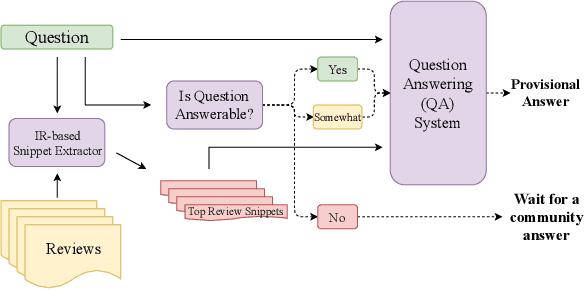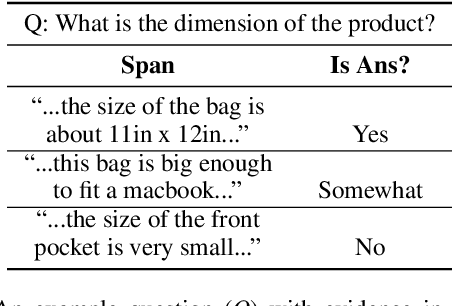Nitish Kulkarni
AmazonQA: A Review-Based Question Answering Task
Aug 20, 2019



Abstract:Every day, thousands of customers post questions on Amazon product pages. After some time, if they are fortunate, a knowledgeable customer might answer their question. Observing that many questions can be answered based upon the available product reviews, we propose the task of review-based QA. Given a corpus of reviews and a question, the QA system synthesizes an answer. To this end, we introduce a new dataset and propose a method that combines information retrieval techniques for selecting relevant reviews (given a question) and "reading comprehension" models for synthesizing an answer (given a question and review). Our dataset consists of 923k questions, 3.6M answers and 14M reviews across 156k products. Building on the well-known Amazon dataset, we collect additional annotations, marking each question as either answerable or unanswerable based on the available reviews. A deployed system could first classify a question as answerable and then attempt to generate an answer. Notably, unlike many popular QA datasets, here, the questions, passages, and answers are all extracted from real human interactions. We evaluate numerous models for answer generation and propose strong baselines, demonstrating the challenging nature of this new task.
Question Relevance in Visual Question Answering
Jul 23, 2018



Abstract:Free-form and open-ended Visual Question Answering systems solve the problem of providing an accurate natural language answer to a question pertaining to an image. Current VQA systems do not evaluate if the posed question is relevant to the input image and hence provide nonsensical answers when posed with irrelevant questions to an image. In this paper, we solve the problem of identifying the relevance of the posed question to an image. We address the problem as two sub-problems. We first identify if the question is visual or not. If the question is visual, we then determine if it's relevant to the image or not. For the second problem, we generate a large dataset from existing visual question answering datasets in order to enable the training of complex architectures and model the relevance of a visual question to an image. We also compare the results of our Long Short-Term Memory Recurrent Neural Network based models to Logistic Regression, XGBoost and multi-layer perceptron based approaches to the problem.
 Add to Chrome
Add to Chrome Add to Firefox
Add to Firefox Add to Edge
Add to Edge